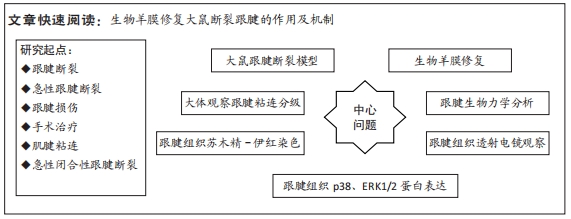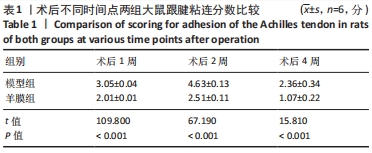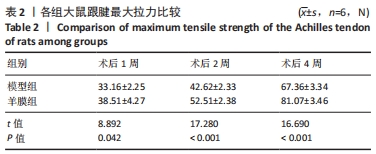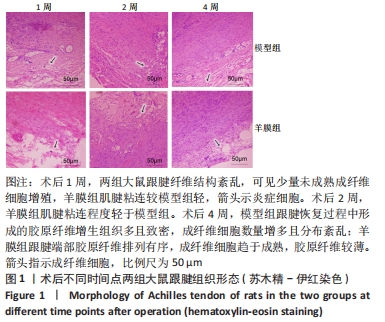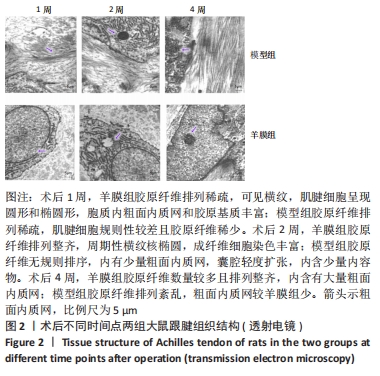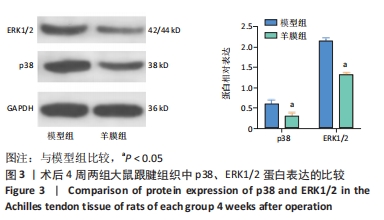[1] NUSS CA, HUEGEL J, FINKIELSZTEIN S, et al. Liquid Poly-N-acetyl Glucosamine (sNAG) Improves Achilles Tendon Healing in a Rat Model. Ann Biomed Eng. 2021;49(2):515-522.
[2] GUNARATNE R, YU CC, YI H, et al. Chronic Achilles tendon rupture: a novel modification of surgical technique described by El Shewy. ANZ J Surg. 2021;91(8): 1447-1450.
[3] NGISSAH R, CHOI JY, HAN SK, et al. Clear Cell Sarcoma of the Achilles Tendon: A Case Report. J Foot Ankle Surg. 2020;59(5):1076-1078.
[4] HUEGEL J, BOORMAN-PADGETT JF, NUSS CA, et al. Quantitative Comparison of Three Rat Models of Achilles Tendon Injury: A Multidisciplinary Approach. J Biomech. 2019;9(8):194-200.
[5] NUNES GS, TESSARIN BM, SCATTONE SR, et al. Relationship between the architecture and function of ankle plantar flexors with Achilles tendon morphology in ballet dancers. Hum Mov Sci. 2019;67(10):102494.
[6] YANG L, LIN L, LIN C, et al. The improved oval forceps suture-guiding method for minimally invasive Achilles tendon repair. Injury. 2018;49(6):1228-1232.
[7] 陈广琴,何金龙,曲楠,等.AMPK/p38 MAPK通路介导黄芪多糖抑制大鼠心肌肥厚的研究[J].广西医科大学学报,2020,37(6):1018-1023.
[8] 吴兴源,张国如.粉防己碱通过NF-κB和MAPK信号通路影响人滑膜细胞炎症及对类风湿性关节炎治疗作用研究[J].广西医科大学学报,2020,37(9): 1636-1641.
[9] GUO Y, JIANG C, YAO S, et al. CTHRC1 Knockdown Promotes Inflammatory Responses Partially by p38 MAPK Activation in Human Periodontal Ligament Cells. Inflammation. 2021;44(5):1831-1842.
[10] 张希妮,王俊清,傅维杰.跟腱运动功能与生物力学特征的研究进展[J].医用生物力学,2019,34(1):103-109.
[11] NAASANI LIS, PRETTO L, ZANATELLI C, et al. Bioscaffold developed with decellularized human amniotic membrane seeded with mesenchymal stromal cells: assessment of efficacy and safety profiles in a second-degree burn preclinical model. Biofabrication. 2022;15(1). doi: 10.1088/1758-5090/ac9ff4.
[12] MATSUI T, KUMAI T, KAMIJO S, et al. Effect of Ankle Motion and Tensile Stress at the Achilles Tendon on the Contact Pressure Between the Achilles Tendon and the Calcaneus. J Foot Ankle Surg. 2021;60(4):753-756.
[13] 马建城,温红.高频超声评估跟腱损伤的研究进展[J].中国医师杂志,2018, 20(12):1913-1915.
[14] WINNICKI K, OCHAŁA-KŁOS A, RUTOWICZ B, et al. Functional anatomy, histology and biomechanics of the human Achilles tendon - A comprehensive review. Ann Anat. 2020;229:151461.
[15] CLAUDIO P, LLOYD DG, ZHENG MH, et al. Finding the sweet spot via personalised Achilles tendon training: the future is within reach. Br J Sports Med. 2019;53(1): 11-12.
[16] YAMMINE K, HONEINE MO, ALAM AE, et al. Locating the danger zone to avoid injury to the sural nerve during Achilles calcaneal tendon repair. A systematic review of cadaveric studies with clinical implications. Surg Radiol Anat. 2022; 44(8):1131-1138.
[17] LAPRADE CM, CHONA DV, CINQUE ME, et al. Return-to-play and performance after operative treatment of Achilles tendon rupture in elite male athletes: a scoping review. Br J Sports Med. 2022;56(9):515-520.
[18] 张希妮,王俊清,杨洋,等.基于跑姿控制训练模式下的跟腱生物力学研究[J].体育科学,2019,39(4):63-70.
[19] KIZILKAYA V, URUC V, LEVENT A, et al. Effectiveness of Ozone Therapy on Tendon Healing: An Experimental Study in Generated Achilles Tendon Injury Model in Rats. J Hard Tissue Biol. 2018;27(4):309-314.
[20] 李莹,陈颖欣,高明宏.干燥生物羊膜移植治疗急性期眼化学烧伤临床效果观察[J].临床军医杂志,2020,48(3):281-283.
[21] 白江博,赵红芳,张冰,等.冻干羊膜重建腱鞘缺损对肌腱愈合的早期生物力学影响[J].河北医科大学学报,2018,39(1):34-38.
[22] 刘露,张霓霓,代敏,等.干细胞与生物材料修复放射性涎腺组织损伤的病理改变及功能重建[J].中国组织工程研究,2021,25(13):2103-2107.
[23] 张骏,杨继滨,金瑛,等.脱细胞羊膜支架复合Scleraxis慢病毒转染的人羊膜间充质干细胞促进兔腱-骨愈合[J].中国组织工程研究,2020,24(13):2061-2067.
[24] LI Z, DAI A, YANG M, et al. p38MAPK Signaling Pathway in Osteoarthritis: Pathological and Therapeutic Aspects. J Inflamm Res. 2022;15:723-734.
[25] GAO P, GAO P, ZHAO J, et al. MKL1 cooperates with p38MAPK to promote vascular senescence, inflammation, and abdominal aortic aneurysm. Redox Biol. 2021;41:101903.
[26] YADAV RK, MINZ E, MEHAN S. Understanding Abnormal c-JNK/p38MAPK Signaling in Amyotrophic Lateral Sclerosis: Potential Drug Targets and Influences on Neurological Disorders. CNS Neurol Disord Drug Targets. 2021;20(5):417-429.
[27] YAO Z, Murali B, Ren Q, et al. Therapy-Induced Senescence Drives Bone Loss. Cancer Res. 2020;80(5):1171-1182.
[28] MURALI B, REN Q, LUO X, et al. Inhibition of the Stromal p38MAPK/MK2 Pathway Limits Breast Cancer Metastases and Chemotherapy-Induced Bone Loss. Cancer Res. 2018;78(19):5618-5630.
[29] FANG J, ZHAO X, LI S, et al. Protective mechanism of artemisinin on rat bone marrow-derived mesenchymal stem cells against apoptosis induced by hydrogen peroxide via activation of c-Raf-Erk1/2-p90rsk-CREB pathway. Stem Cell Res Ther. 2019;10(1):312.
[30] FUJISAKI S, KAJIYA H, YANAGI T, et al. Enhancement of jaw bone regeneration via ERK1/2 activation using dedifferentiated fat cells. Cytotherapy. 2021;23(7):608-616.
[31] Li L, WANG Y, WANG Z, et al. Knockdown of FOXA1 enhances the osteogenic differentiation of human bone marrow mesenchymal stem cells partly via activation of the ERK1/2 signalling pathway. Stem Cell Res Ther. 2022;13(1):456.
[32] 卞旭廷.雌激素β受体在小鼠跟腱损伤修复中的作用及机制研究[D].重庆:陆军军医大学,2020.
[33] ZHANG J, WANG L, CHU J, et al. Macrophage-derived neurotrophin-3 promotes heterotopic ossification in rats. Lab Invest. 2020;100(5):762-776.
[34] ZHANG B, LUO Q, MAO X, et al. A synthetic mechano-growth factor E peptide promotes rat tenocyte migration by lessening cell stiffness and increasing F-actin formation via the FAK-ERK1/2 signaling pathway. Exp Cell Res. 2014;322(1):208-216.
[35] JING Y, REN Y, WITZEL HR, et al. A BMP4-p38 MAPK signaling axis controls ISL1 protein stability and activity during cardiogenesis. Stem Cell Rep. 2021;16(8): 1894-1905.
[36] 张治金,曾林如,朱芳兵,等.羊膜衍生膜负载干细胞通过PI3K/MAPK修复及优化软骨损伤的评估[J].中国现代医生,2017,55(18):31-34.
|
